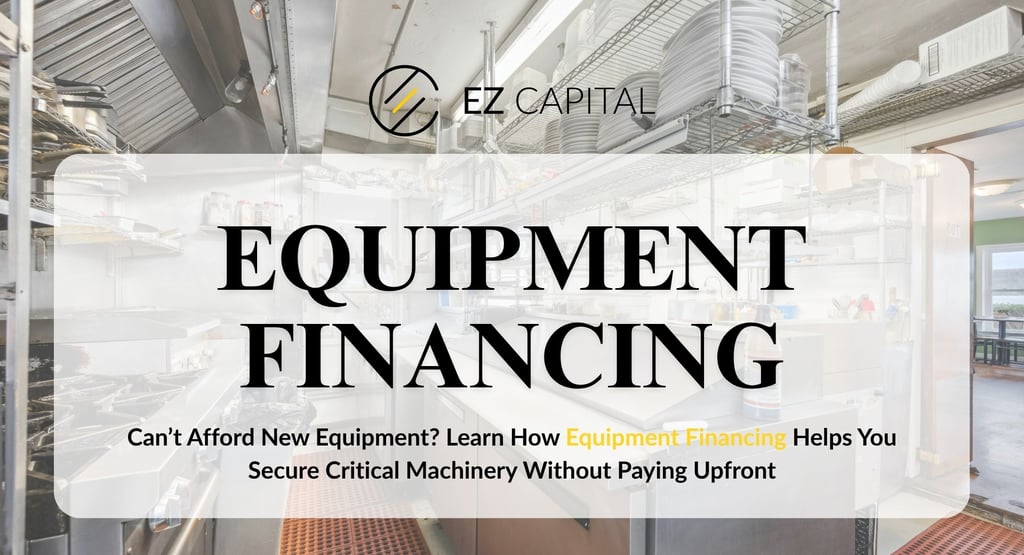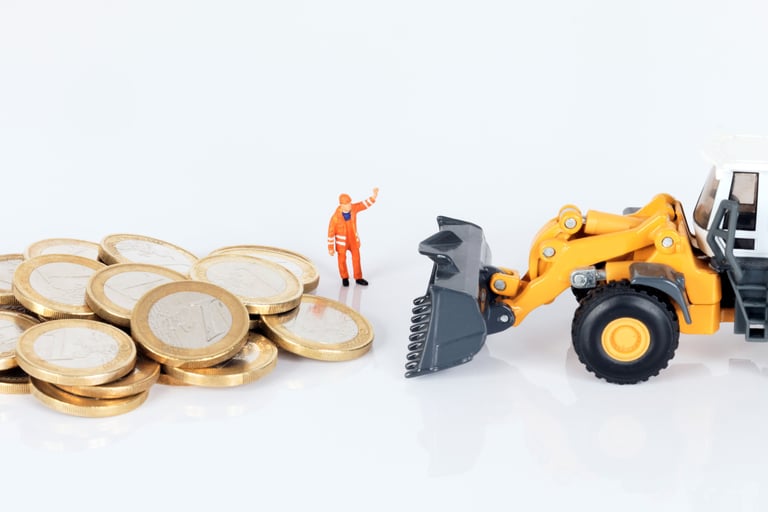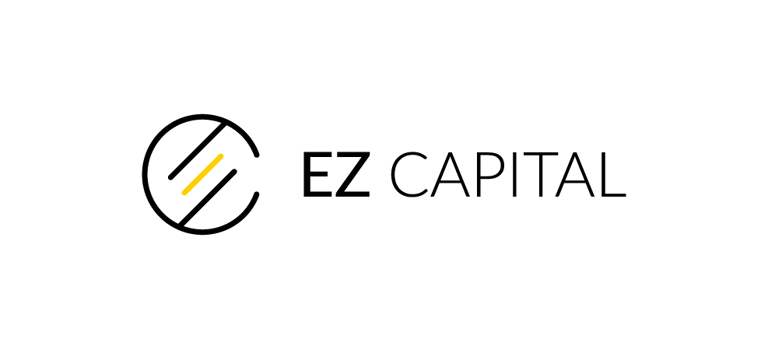Equipment Financing 101: How Small Businesses Can Afford the Equipment They Need
Equipment financing refers to a type of funding specifically designed to help businesses acquire the business equipment they need.
ENGLISH
Xinyan He
8/7/202510 min read


Mr. Zhang runs a Chinese restaurant in New York. Recently, his kitchen’s stove and refrigeration units began breaking down and needed replacement. However, commercial-grade restaurant equipment can easily cost tens of thousands of dollars—far more than his tight cash flow could support.
This is a common dilemma among small businesses across the U.S.—whether it's a restaurant upgrading its kitchen, a manufacturing plant adding production equipment, or a logistics company purchasing trucks and forklifts. So the question is: Where does the funding come from? Is there a financing option that lets you acquire equipment quickly without draining your bank account or pledging real estate as collateral?
That’s where Equipment Financing comes in—a go-to solution for many small business owners. With relatively low credit requirements, no need for outside collateral, and access to tax deductions on both interest and depreciation, equipment financing offers a highly practical way for small businesses to expand their operations.
But what exactly is equipment financing? What types are available? What are the key terms and how do you apply? This article will walk you through everything you need to know.
1.What Is Equipment Financing?
Equipment financing refers to a type of funding specifically designed to help businesses acquire the business equipment they need. It typically takes the form of either a loan or a lease. With equipment financing, businesses can obtain the necessary machinery without paying the full amount upfront and instead repay the principal and interest over time. The equipment itself often serves as collateral for the financing. Commonly financed items include office computers, printing presses, kitchen stoves, production line machinery, commercial vehicles, and other tangible business-use equipment.
2. Main Types of Equipment Financing
There are two primary forms of equipment financing: equipment loans and equipment leases. The two differ significantly in terms of ownership structure and payment methods:
(1) Equipment Loan
Under an equipment loan, the lender provides capital for the business to directly purchase the equipment. The business repays the loan in installments. The equipment is immediately put into use by the business, and full ownership is transferred once the loan is paid off. It’s similar to a mortgage—once the repayment term ends, the equipment is yours.
Rate: The specific rate depends on factors such as credit score, financial health of the business, and the type of equipment. Most loans allow for early repayment to save on interest.
Loan Term: Typically ranges from 1 to 5 years; larger or heavy-duty equipment purchases may qualify for terms up to 7–10 years. The term is usually aligned with the useful life of the equipment.
Loan Amount: Loan sizes range from $5,000 to several million dollars. Most lenders do not finance 100% of the equipment value; borrowers are often required to make a down payment of 10–20%. Some lenders offer zero-down options depending on the borrower's qualifications and the equipment value.
Repayment Frequency: Most loans are repaid monthly. Some lenders may offer biweekly or seasonal repayment options to accommodate business cash flow. Standard repayment is through equal monthly installments covering both principal and interest.
Collateral and Guarantee: The purchased equipment usually serves as the sole collateral. No additional assets are required, but most lenders still require a personal guarantee from the business owner.
🌟 Tax Treatment: Equipment purchased through a loan offers two major tax benefits: (1) the interest paid on the loan is deductible as a business expense; and (2) the equipment can be depreciated for tax purposes. In other words, you may benefit from both interest and depreciation deductions.
👉 Example:
If you pay $5,000 in interest over the course of a year for an equipment loan, that $5,000 is treated as a legitimate business expense and can be deducted before taxes, reducing your taxable income and saving on corporate income tax.
The IRS has a special provision called Section 179, which allows eligible businesses to deduct most or all of the equipment cost in the first year of purchase (subject to a maximum limit). For instance, if you purchase a $50,000 piece of equipment, it would typically be depreciated over five years. But under Section 179, you may be able to deduct the full $50,000 in the first year (based on applicable limits), significantly lowering your taxable income for that year.


(2) Equipment Lease
In an equipment lease, the lender purchases the equipment and rents it to the business. The business pays monthly rental fees but does not own the equipment during the lease term. At the end of the lease, the business may choose to purchase the equipment at a predetermined price, renew the lease, or return the equipment. It’s similar to renting a property—you pay for usage, not ownership.
There are two main types of equipment leases: operating leases and capital leases, which differ primarily in lease terms and how the equipment is handled at the end of the lease:
Operating Lease: Usually has lower monthly payments and shorter terms (typically 2–7 years). At the end of the term, the business may purchase the equipment at fair market value, return it, or upgrade to a new model. Since the term is short and equipment may need to be returned, this option is well-suited for assets that become obsolete quickly or are frequently updated.
Capital Lease: Structurally more like a loan, with higher monthly payments. At the end of the lease term, the equipment can usually be purchased at a symbolic price (e.g., $1 or 10% of the original cost). During the lease, the equipment is typically treated as an owned asset on the business’s balance sheet. Capital leases effectively allow a business to gradually acquire ownership, with financial treatment similar to an equipment loan.
👉 How to Choose?
Generally, if the equipment will be used long-term (e.g., more than 3 years) and the business intends to own it eventually, an equipment loan or capital lease is preferable. For short-term usage (under 3 years) or rapidly evolving technology, an operating lease may help reduce obsolescence risk.
Rate: Lease rates typically fall between 1.1–1.5, meaning the total financing cost is 110%–150% of the equipment’s value, subject to final approval terms.
Lease Term: Flexible—commonly set at 2, 5, or 10 years depending on the equipment’s use and expected life cycle.
Lease Amount: Most leasing companies offer 100% financing with no down payment required. Only the first month’s rent and a deposit are typically needed to begin using the equipment.
Repayment Frequency: Lease payments are usually fixed monthly and cannot be repaid early to save interest. Some lessors may offer quarterly or semiannual plans. Early termination is generally not allowed unless the lessee pays a penalty or the full remaining amount.
Collateral and Guarantee: The equipment is owned by the leasing company, so no additional collateral is required. However, most lessors still require a personal guarantee from the business owner.
🌟Tax Treatment: Lease payments are typically treated as operating expenses and are fully tax deductible. For operating leases, the lessee cannot claim depreciation (since they don’t own the asset). For capital leases or lease-to-own agreements, the lessee may treat the equipment as a capital asset and depreciate it over time.
Tap to see how much you could qualify for 👉
3. Advantages and Disadvantages of Equipment Financing
✅ Advantages
Preserve Cash Flow and Support Expansion:
Using equipment financing—whether via loan or lease—allows businesses to avoid large upfront capital expenditures. This helps preserve working capital for daily operations or other investments. With small monthly payments, you can leverage financing to unlock greater productivity and business growth.Easier Approval and Flexible Collateral:
Because the equipment itself serves as collateral, lenders take on less risk. As a result, equipment loans often have lower qualification requirements than unsecured business loans. Even businesses with average credit or limited history may still be eligible. The equipment’s inherent value and resale potential are key factors in the approval process.Ownership and Long-Term Value:
When you finance equipment through a loan, you gain full ownership once the loan is repaid. The equipment becomes a business asset that can be resold or refinanced in the future and may retain residual value over time. In addition, equipment purchases can benefit from depreciation deductions and Section 179 tax incentives. Loan interest is also tax deductible as a business expense.Boost Productivity and Seize Opportunities:
Acquiring new or upgraded equipment can significantly improve efficiency and output, helping you stay competitive and increase revenue. Equipment financing ensures you don’t miss out on business opportunities—when new contracts or expansion plans arise, you can acquire the tools you need even without upfront capital.Fixed Rates and Predictable Costs:
Most equipment loans come with fixed interest rates and fixed repayment schedules, making it easier for business owners to budget with confidence. With predictable monthly payments, you won’t be caught off guard by rate fluctuations or hidden fees.
❌ Disadvantages
Higher Total Cost:
Compared to paying cash upfront, financing introduces additional costs such as interest and potential service fees. Even if the rate is reasonable, the cumulative cost over time will exceed the original purchase price. With equipment leases, the total payments are often higher than the equipment’s actual value.Risk of Obsolescence and Maintenance Burden:
Technology evolves rapidly. Equipment may become outdated before the loan is fully repaid. If you own the equipment, any depreciation or loss in value is your responsibility. Additionally, ongoing maintenance and soft costs like repair costs fall on the business. (In contrast, some leases include maintenance services.)Credit and Asset Risk:
If you miss payments, the lender may repossess the equipment, disrupting your operations. Defaults can also damage your credit score and, if a personal guarantee is involved, even put your personal assets at risk. Therefore, it’s important to assess your cash flow and repayment capacity before entering into an equipment financing agreement.


4. Qualification Requirements for Equipment Financing
Although equipment financing tends to be more accessible than other types of business loans, borrowers must still meet certain baseline criteria. The following are general eligibility requirements across most lenders:
Time in Business:
Most lenders prefer that the business has been operational for at least 6 to 12 months. The longer your business has been in operation, the stronger your application. Startups operating for less than six months may face difficulty obtaining financing, although certain lenders do offer programs tailored to new small businesses.Annual Revenue:
Lenders typically require businesses to demonstrate stable income to support repayment. Minimum annual revenue requirements usually range from $25,000 to $150,000, with some lenders accepting businesses earning as little as $20,000–$30,000 annually. Higher and more consistent revenue generally increases your chances of approval and qualifies you for lower interest rates.Credit Score:
Many lenders accept personal credit scores as low as 500, though a higher score will improve your terms. A strong credit score (e.g., 680 or above) makes it easier to get approved and may qualify you for rates below 10%.Residency Status:
Most lenders require the business owner to be a U.S. citizen or permanent resident (green card holder).Equipment Type:
Lenders typically prefer equipment that holds its value and is easily resold. If you’re seeking financing for highly customized, niche, or fast-depreciating equipment—such as specialized machinery or used equipment—this may impact your loan terms or approval amount. Some lenders may impose additional restrictions on age or resale potential.


5. Frequently Asked Questions
(1) Can I use equipment financing to purchase used equipment?
Yes, but conditions may vary. Many lenders do offer financing for used equipment—especially for heavy equipment like large machinery and vehicles—because pre-owned assets are more affordable. However, since used equipment presents higher risk, the interest rate may be slightly higher and the loan term may be shorter.
Some lenders may also impose limits on the age or usage history of the equipment—for example, only financing trucks that are less than five years old. In addition, certain lenders may not accept equipment purchased from private sellers or auctions, and may require that the purchase be made through an authorized dealer. You may also need to provide an equipment valuation report or proof of clear ownership.
(2) Are loan interest and lease payments tax deductible?
In most cases, yes. In the U.S., interest paid on equipment loans is considered a business expense and is deductible from taxable income. This reduces your company’s taxable profit and, in turn, your tax liability.
In addition, equipment depreciation can also be claimed annually. Under IRS Section 179, qualified businesses may deduct most or all of the equipment cost in the year it’s purchased, subject to applicable limits.
For leases, the treatment depends on the lease type: Operating lease payments are generally fully deductible as operating expenses. Capital lease payments are treated similarly to loans: you may deduct the interest portion of payments and depreciate the equipment over time.
Be sure to consult your accountant to determine the most beneficial tax treatment for your business. In either case—loan or lease—equipment financing offers significant tax advantages.
(3) How long does it take to receive funding?
At EZ Capital, we understand that time is critical for business owners, especially when equipment is urgently needed. Our dedicated loan specialists will guide you through the application process and ensure a smooth experience.
In many cases, you can get approved within 24 to 48 hours. Whether you’re replacing a stove, expanding your fleet, or seeking financing for the first time, EZ Capital offers fast, reliable financing solutions trusted by business owners across industries.
Still have questions about how equipment financing works or whether it fits your business needs? Contact the EZ Capital team for a free, personalized consultation. We’ll help you evaluate your options and design a financing plan tailored to your goals.
EZ Capital is a smart business financing platform dedicated to empowering small business owners with tailored lending solutions. We help you compare funding options quickly and confidently—so you can move forward with clarity and momentum.
We wish you great success in funding and growth! 🚀


© EZ Capital 2025. All rights reserved.
Fulfillment Policy | Privacy Policy | Terms and Conditions of Service
EZ Capital is a financial technology company, not a bank. Business financing is provided by EZ Capital and/or its partners.
All applications are subject to approval. Additional fees may apply.
Certain financing products and/or services may not be available in certain states.




